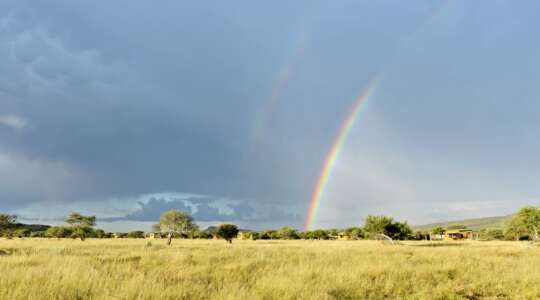Speak to one of our experts now about this offer
Call our Africa experts on0800 294 9706
Available until 2pm
Okonjima Bushcamp lies on the Okonjima Nature Reserve, a former cattle ranch that’s now a conservation success story and home to the AfriCat Foundation.
Okonjima is one of the best places to see leopard in Namibia, largely due to the reserve’s predator research programme. Enjoy game drives and nature walks with expert guides, where you may see oryx, giraffe, zebra and brown hyena. Meet the big cats at the AfriCat foundation and get involved in rhino, leopard or pangolin tracking.
The architecture at Okonjima Bush Camp is inspired by nature, with curved lines and ochre colours that echo the sandstone Omboroko Mountains.
Why we love Okonjima Bush Camp
-
The chalets have huge glass windows, so you can lie in bed and maybe see oryx, giraffe and zebra wander by
-
Learn about big cat conservation at the AfriCat Carnivore Care Centre, which is home to rescued cheetahs
-
There are a number of self-guided nature trails to explore
-
Head out at night with a guide and tracker in search of the endangered pangolin
Unique experiences
Track endangered rhinos and pangolins at Okonjima
Track endangered rhinos and pangolins with the help of the AfriCat team and anti-poaching units at Okonjima. You’ll move quietly on foot, getting up close to rhinos as they graze or lie in the shade. At Okonjima, they are also lucky to have a population of ground pangolins, one of the four pangolin species living on the African continent.
Meet AfriCat’s rescued cheetahs
Learn about big cat conservation at the AfriCat Carnivore Care Centre, which is home to rescued cheetahs that unfortunately cannot be released into the wild. Perhaps they’re injured, elderly or arrived at the centre at such a young age that they’ve never learned to hunt. Now, they act as ambassadors for their species and live peacefully in up to 50-acre enclosures on the Okonjima Reserve.
Okonjima game drive
Take game drives in Okonjima Nature Reserve to spot leopards and endangered species. Okonjima is also home to the AfriCat Foundation, which has been researching leopards here since the 1990s. Some of the leopards are fitted with tracking collars that allow them to protect and monitor the population while they roam freely within the reserve.
Facilities
The heart of the camp is the camelthorn pod-shaped lapa, which is home to the lounge and restaurant. The menu offers everything from a breakfast buffet where the chef can cook you up a special bushman’s omelette, to local venison and produce grown in their gardens.\
When you head out on a game drive, expert guides will be able to tell you all about how each species you spot fits into this conservation area. Guests love to wander the nature trails and take specialist activities like rhino tracking and, when the weather permits, exciting night drives.
Okonjima is committed to wildlife conservation. The AfriCat Foundation's rehabilitation programme was launched in the 1990s to rescue cheetahs and leopards from livestock farmers. Since then, the foundation has expanded with the aim of protecting all carnivores in Namibia. You can learn about AfriCat’s mission and predator programme at the information centre and clinic.
Children over the age of 12 are welcome.
All Hotels in Ojiwarongo & Okonjima
Sorry, your hotel is no longer available
Please check alternatives
-
{{item.body}}
-
{{item.body}}
Choose a departure date
{{store.searchDuration}} nights
Enter rooms & guests
Checking prices & availability

{{term}}, {{formattedDate}} for {{searchDuration}} nights


_w=24_h=25.png?v=910f6de5506872363a0d58b9f40775d869aae637)
_w=24_h=25.png?v=910f6de5506872363a0d58b9f40775d869aae637)
_w=24_h=25.png?v=910f6de5506872363a0d58b9f40775d869aae637)